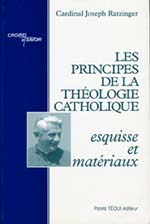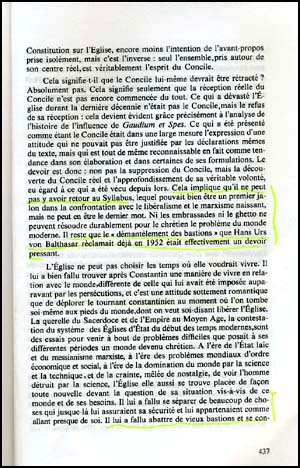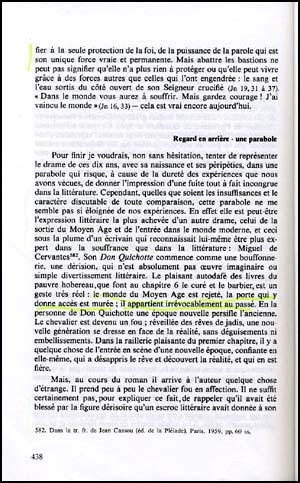In his book Principles of Catholic Theology, first published in 1982, Card. Joseph Ratzinger pictured the crisis inside the Church as a consequence of Vatican II. Then he asked: Should the Council be revoked?
In his answer, he categorically affirmed that the Church cannot return to the principles of the Syllabus of Pius IX. He also stated that razing the bastions of the Church, as Fr. von Balthasar had proposed, was an urgent duty of Catholics.
Top right is a picture of the book's cover; at right, photocopies of the French text. Below, we present our translation.
Does this mean that the Council itself should be revoked? Absolutely not. It only signifies that the real reception of the Council has not yet begun. What has devastated the Church in the last decade is not the Council, but a refusal to receive it: this became evident thanks to analysis of the influence of Gaudium et spes. What has been presented as the Council was in large measure an attitude that could find no justification in the affirmations of the text itself, but rather were [just] tendencies in its elaboration and some of its formulations.
The duty is, therefore, not to suppress the Council, but to discover the real Council and delve deep into what it truly wants with regard to what has happened since then.
This implies that there is no possible return to the Syllabus, which could well have been a first step in the combat against Liberalism and the nascent Marxism, but which cannot be the last word. Neither embraces nor the ghetto can resolve the problem of [relations with] the modern world for the Christian. Hence, the 'razing of the bastions' that Hans Urs von Balthasar called for already in 1952 was in effect an urgent duty ....
It was necessary for her [the Church] to raze the old bastions and confide only in the protection of the faith, the power of the word that is her unique, true, and permanent strength. But to raze the bastions cannot signify that she no longer has anything to protect, or that she can live owing to different forces than those that engendered her: the water and the blood that poured from the open side of her crucified Lord.
(Les Principes de la Theologie Catholique - Esquisse et Materiaux, Paris: Tequi, 1982, pp. 437-438).
|



|

Posted on November 13, 2005
|
